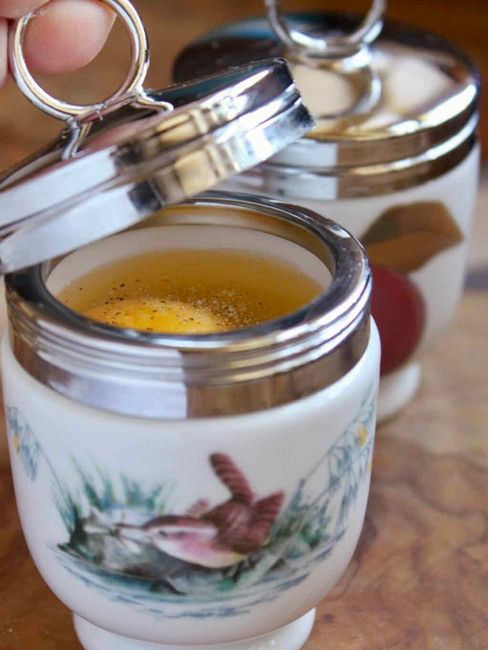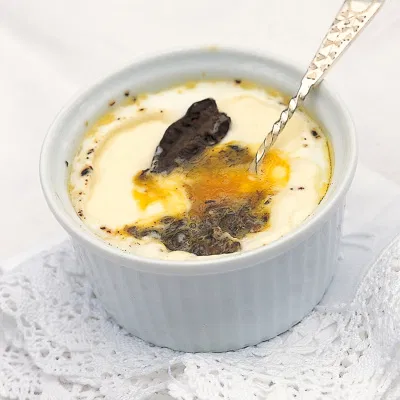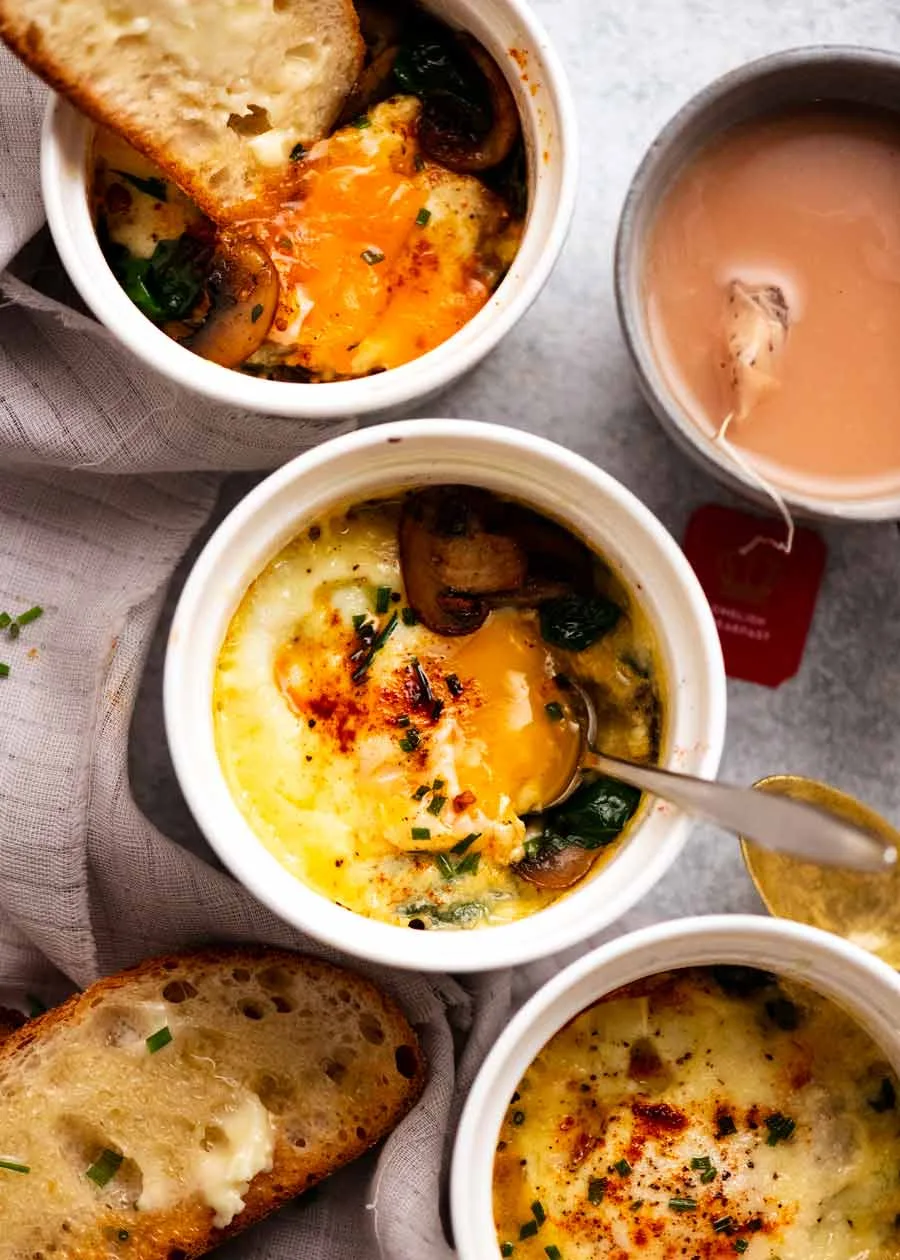Genteel eggs
- rosemary
- May 27
- 6 min read
Coddled, baked, shirred, en cocotte, moulded eggs, egg-in-a-cup - not poached - but I'm confused

This all began with this rather lovely looking Coddled eggs Ivanhoe from Rosie Sykes in The Guardian. In my youth I ate boiled eggs, scrambled eggs, fried eggs, and poached eggs, but never coddled eggs. So somehow in my head I had the impression that coddled eggs were something special, and somehow also upper class. Downton Abbey and all that. Refined.
When I got into my young wife cooking days with Elizabeth David, Jane Grigson and Robert Carrier, I think I came across them here and there, and somewhere there I found there were also oeufs en cocotte, which I thought, I now know mistakenly, were the same thing. So when I saw the above I decided I would investigate.
My notions of this being an upper-class kind of thing was confirmed when I came across a simple recipe for Coddled eggs from Christina's Cucina, because she told how she had been gifted a Royal Worcester egg coddler by a friend, had fallen in love, bought another and now made coddled eggs all the time. I'm not at all sure whether you can actually buy new ones, but vintage ones are available - at a price. Not a really stupid price but a bit of a splurge.
Of course you don't have to use a proper egg coddler, and anyway I'm sure there are cheaper ones - if you can find them. The Americans tell you to use a Mason jar, Rosie Sykes suggested a jam jar of the appropriate shape - or, she said, you could just cover your ramekin style dish with foil. The proper ones come with a screw on lid as you can see. You butter your pot generously, break your egg into your container, place your dish or dishes in a baking dish with boiling water which comes halfway up the sides, and cook in the oven until the yolk is still runny and the whites cooked.

I'm pretty sure that this is the correct way to cook a coddled egg, but this is when I started to get confused. The first difference being, that although one generally eats the egg straight from its dish, you can remove it and put it on toast ... as shown in this version of Coddled eggs from Wholesom Yum. You'd have to be sure that you greased your dish plentifully though to be sure it would come out.
Then it starts to get more complicated. The basic coddled egg, is just an egg. But of course, like my 'starter' Ivanhoe version which featured smoked haddock amongst other things, you can add whatever takes your fancy - from a simple splash of cream - around the egg, not over the top - to various additions from cheese or mushrooms to that smoked haddock, underneath and on top. Mind you this seems to happen less with the coddled egg, than with the baked egg, which I shall come to shortly.

Before I leave the genuine coddled egg however, I should mention that you can also coddle them on the stove-top. Put a pan on the hob, pour in water, heat to boiling and then put in your pots. To make sure you have the right height for the water you could put the pots in the pan, pour in your water, then place on the hob. I guess it would be better to then remove the pots, before replacing them when the water has boiled, or maybe you could leave them there and break the eggs into them when the water has boiled.
Food 52 has a very useful, very short little video on How to use an egg coddler
So far, so good. Coddled eggs - cooked in a bain marie with a lid of some kind on top of your coddling dish, with or without additional extras. The finished egg is a bit like a poached egg:
"The coddled egg is aided by a steamy environment, resulting in a texture similar to that of a poached egg, with a set white and a runny yolk, in contrast to the firmer texture of baked eggs." Rosie Sykes/The Guardian

Yes baked eggs - for I then came across shirred eggs, baked eggs, and ouefs en cocotte, but also when I was looking for recipes I found quite a few which although called coddled, were not cooked covered in a bain marie, and not with a lid. Confusing. Well I now think those people - including the lovely Jamie who has a recipe for these Peperonata coddled eggs are just wrong.
What we have here are baked eggs, otherwise known as shirred eggs or, in France, or if you want to sound posh - as Oeufs en cocotte.
Baked eggs are like their name, and, generally speaking include other ingredients.

And here is the classic version from Elizabeth David. Interestingly she calls them Baked eggs, but qualifies it with (Oeufs en cocotte) - Baked eggs (oeufs en cocotte). All she has done has poured some cream around the egg - 'a large spoonful' and then baked until done to your preference, offering these somewhat schoolmarmish comments at the end:
"Experience and knowledge of the idiosyncrasies of one's own oven are the mediums of success here. No pepper or salt should be added, except at the table, but a very little cut fresh tarragon when they come out of the oven is an acceptable addition."
Others are much less cautious: Jamie shows you Baked eggs 3 ways on YouTube; Kitchn just adds some herbs and cheese and calls them Shirred eggs with toast soldiers; Delia goes for mushrooms - Eggs en cocotte with morel or porcini mushrooms as does Nagi Maehashi of Recipe Tin Eats - who calls hers Shirred eggs - baked eggs with spinach and mushrooms, telling us that:
"Shirred eggs get their name from the traditional dish in which they are baked, a small gratin dish called a shirrer. Unlike French oeufs en cocotte or coddled eggs, shirred eggs are not baked immersed in a water bath." Nagi Maehashi
And then there's Luke Nguyen who puts a Vietnamese twist to his Eggs cocotte with Lap Cheong - a Chinese sausage. The recipe is not online but if you click on the photo you will probably be able to read it:
Kitchn mention moulded eggs as well but I think this is just baking eggs in fancy shaped moulds rather than a plain ramekin.
You can see, with the baked version, particularly when you look at versions such as Jamie's how this particular technicque is used elsewhere for shakshuka, and huevos rancheros and other such dishes, in which you cook some sort of vegetable base, and then break your eggs into them. I suppose the difference there is that the dish is generally finished on the stove top, not in the oven.

Finally Tara Holland, on The Kitchn website began her article on, and recipe for Coddled eggs, (with bacon) with this very working class version of what her father called egg-in-a-cup and which he would make for them when she was a child:
"To make it, my dad would put about a couple of tablespoons of salted butter in a mug, then spoon out the contents of a perfectly cooked soft-boiled egg into the mug — all while trying not to get third-degree burns from holding the hot egg. Then, he’d add a large pinch of salt and a generous pinch of ground white pepper. He’d beat the egg into the butter, using a teaspoon, until the butter was melted and melded into the eggs and became a cup of buttery, yolky deliciousness. And he always served the dish with toasted buttered white bread cut into soldiers alongside. These coddled eggs are similar to this cherished dish from my childhood — only easier." Tara Holland/The Kitchn
Different again and also a different technique it has to be said, but maybe a similar result. And not poached eggs - they are just cooked in boiling water, unprotected by dishes, pots or jars.
As I said, I've never made coddled or baked eggs, but I might have a go sometime soon - for lunch one day perhaps. David would hate them.

POSTSCRIPT
One of life's little coincidences. On my New York Times desk calendar up popped this recipe for Honey butter grilled corn from J. Kenji López-Alt which is basically the Mexican elote - although they probably sprinkle their corn with other things. There would be chilli involved I'm sure.
And I've been pondering some more on the world-wide popularity of Mexican food. Italian I can sort of understand because Italians have spread themselves all over the world. Mexicans not so much I would think. Even here in Australia I suspect there are more Latin Americans from places like Argentina and Chile than Mexico. Maybe, in fact, what the world thinks is Mexican is really Tex-Mex spread by fast food companies like Taco Bell.
YEARS GONE BY
May 27
2024 - Nothing
2023 - Why don't they cook? - obviously this is bugging me. I seem to revisit this issue on a regular basis. Apologies. I still have no answer by the way. Or maybe that should be - no solution.
2022 - Plain is yummy - two tarts
2020 - Deleted
2017 - Nothing - I think I was in France














Curiously i have two matching coddlers which i havent used ery often. Might be Wedgewood.
Coddled Eggs sounds as if they have been put in some protective zone, pampered and cared for somewhat indulgently. You're right not what David would like! The only eggs I eat are omelettes and scrambled, preerable with bacon or salami or ham - something to hide the taste of the egg!🫠